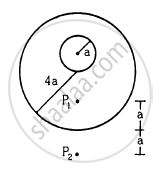Advertisements
Advertisements
Question
State Newton's law of gravitation. What is the difference between:
g and G?
Solution
Newton law of gravitation is that every object in the universe attracts every other object with a force directly proportional to the product of their masses and inversely proportional to the square of the distance between them.
'g' is the acceleration due to earth's gravity and 'G' is universal gravitational constant.
APPEARS IN
RELATED QUESTIONS
A person sitting in a chair in a satellite feels weightless because
Two small bodies of masses 10 kg and 20 kg are kept a distance 1.0 m apart and released. Assuming that only mutual gravitational forces are acting, find the speeds of the particles when the separation decreases to 0.5 m.
A tunnel is dug along a diameter of the earth. Find the force on a particle of mass m placed in the tunnel at a distance x from the centre.
A uniform metal sphere of radius a and mass M is surrounded by a thin uniform spherical shell of equal mass and radius 4a (In the following figure). The centre of the shell falls on the surface of the inner sphere. Find the gravitational field at the points P1 and P2 shown in the figure.

A ball is thrown up with a speed of 4.9 ms-1.
Prove that the time of ascent is equal to the time of descent.
Explain why:
The atmosphere does not escape.
Show that gravity decreases at higher altitudes.
Solve the following problem.
Calculate the acceleration due to gravity at a height of 300 km from the surface of the Earth. (M = 5.98 × 1024 kg, R = 6400 km).
Give the applications of universal law gravitation.
Observe the figure and answer the questions:

- State Newton's universal law of gravitation.
- If the distance between the two bodies is tripled, how will the gravitational force between them change?
- What will happen to gravitational force, if mass of one of the object is doubled?
